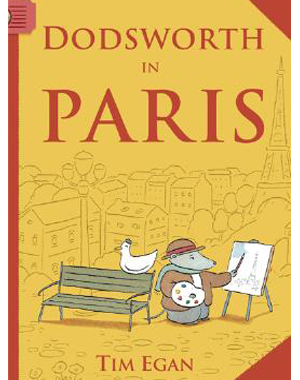Metropolitan Cow
Bennett Gibbons, a young calf in a prominent cow family, is forbidden to befriend a nice young pig, Webster Anderson, because he was, after all, a pig.Bennett runs away, but Webster finds him, and the families become friends, taking delightful (if undignified) mud baths together. The splendid romp through bovine and porcine prejudice is made more pointed by the extremely urban and sophisticated setting, portrayed in richly colored watercolor and ink illustrations.
Horn Book
Bennett Gibbon is a lonely bovine, the only calf in his part of town. Then a little pig, Webster Anderson, moves into the apartment next door. The two become comrades, much to the dismay of Bennett’s parents, who have some mighty intolerant ideas about pigs. Egan sculpts the message smoothly into the story, and while his writing demonstrates a light touch, the artwork provides a smart counterpoint. A Deco air invests the story with a droll mood and city shadows–the colors are muted, and the wit is urbane.
Kirkus Reviews
Bennett Gibbons is an upper-class calf whose privileged lifestyle exposes him to all the perks of urban high society. He wistfully watches a family of pigs wallowing in the mud at the park, but his parents explain that cows are too dignified for such nonsense. The thinly veiled message could have become heavy handed if not for Egan’s witty language and amusing illustrations. His watercolor paintings are enlivened by little details?George Seurat’s Sunday Afternoon in the Park with cows hangs in the Bennett apartment, and a poster for Swine Lake adorns the wall of a theater. In addition, these funny characters don’t take themselves as seriously as the words might indicate. In the end, Mr. and Mrs. Bennett discover that mud baths can be refreshingly liberating. Unabashed lighthearted fun.
School Library Journal
A sly look at the tensions caused by class and race–or, more correctly in this case, species. Told in a wry voice, yet kidlike in its essence, this appealing story, with its very New York setting, is lifted to a higher level by the delightfully offbeat ink-and-watercolor art. Dressed in similar thirties-style garb, the pigs and cows are intentionally sometimes hard to tell apart; both are as round as Weebils and the exact same color. Children will catch on that any animosity comes from the head, not from real differences. Isn’t that silly?
Ilene Cooper, Booklist
In a scenic art-deco city, pigs collect tickets from movie-going cows, and a generous cow gives coins to some piggy street musicians. This social hierarchy remains unquestioned until Bennett, a lonely calf, makes friends with his porcine neighbor, Webster. Both are too young to know any better, though Bennett’s father harrumphs, “Frankly, Bennett, it’s a little unusual for a cow to be playing with a pig.” Yet after Bennett’s irresistible urge to play in the mud brings his and Webster’s families together, they realize they have a lot in common: “They all liked the same music and the same books. And they all were vegetarians.” Egan’s watercolor-and-ink illustrations are composed with an eye for balance, and his sophisticated palette of pine green, burgundy and creamy yellow conveys the cows’ celebrated “dignity.” The grand apartment buildings and the animals’ dapper dress suggest prewar New York; 20-cent pretzels and Webster’s porkpie hat reinforce the nostalgic motif.
Publishers Weekly


